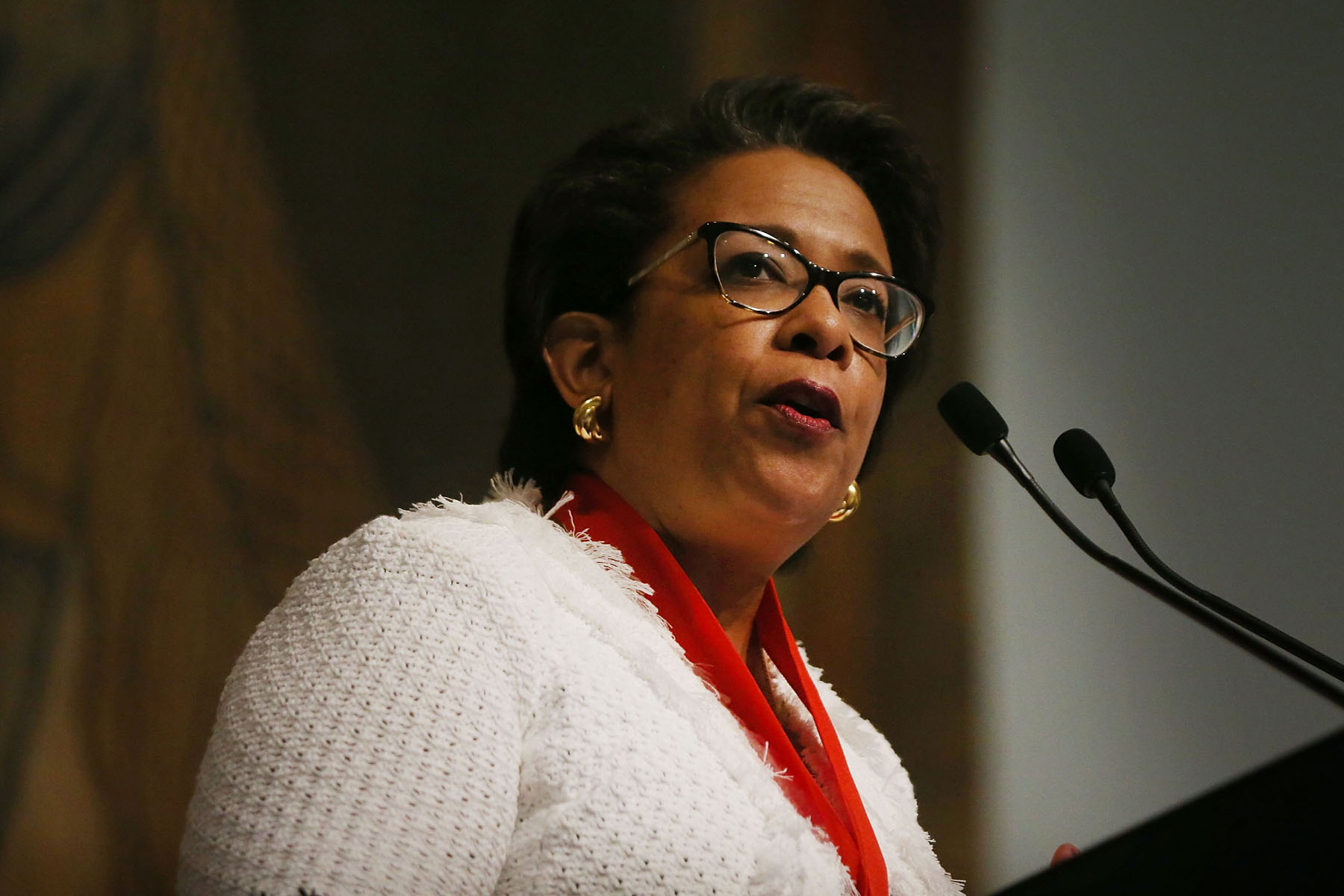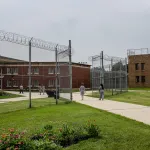Women represent only about 10 percent of incarcerated people in the United States. Because of that, most criminal legal research and reform proposals overlook their specific needs.
A growing number of researchers and advocates are pushing to change this. They’re calling for a more intentional focus on the factors that lead women to incarceration, the challenges they face inside and the limited available resources to help them re-enter society.
This month, the nonpartisan Council on Criminal Justice launched a new Women’s Justice Commission to address some of these gaps. It is led by former U.S. Attorney General Loretta Lynch and made up of 15 other members who include academics, legislators, law enforcement and advocates.
The commission has released two reports that capture the existing data and research on women in the criminal legal system. It will then use this information to assess each step of women’s experiences with incarceration — pre-arrest, policing, conditions of confinement and release — and determine a list of policy recommendations.
The 19th spoke with Lynch and the commission’s director, Stephanie Akhter, about their work and the barriers for more robust criminal legal research on women.
This interview has been edited for length and clarity.
Candice Norwood: I would love to hear about the background of this Women’s Justice Commission and what led to its creation.
Loretta Lynch: The Council on Criminal Justice is a bipartisan, evidence-focused research organization that tries to bring an objective, thoughtful and substantive eye to the challenges within the criminal justice system. I initially began working with them in the early stages of the COVID shutdown. I worked with a group that focused on providing policy recommendations for how the system should be dealing with the COVID-19 crisis.
And one of the hardest nuts to crack in the criminal justice system — aside from the overall issues of overincarceration and racial disparities — is how women have fared in the criminal justice system.
So much of what we know now is that a lot of the harshest methods that we’ve used in incarceration just aren’t effective, in either preventing recidivism or preparing people to be contributing members of society when they eventually are released. When you look at the situation for women, lots of times their unique needs really don’t get addressed in the system.
-
Read Next:
The commission includes experts from different areas of the criminal legal system. Can you talk through what you want to accomplish with this group?
Lynch: I think the benefit of the variety of voices is that these are commissioners who have deep experience with every different stage for women: arrest, initial incarceration, incarceration and then reentry. Oftentimes, you need that variety of perspectives, because it really informs the policy recommendations you come up with.
So many times people come up with well-meaning policies, but because we’re only viewing it from one lens, we don’t know that down the road it’s actually not going to be effective.
We have some research that we will be building on, but we will be commissioning research projects. That’s what a lot of the staff will be dealing with, along with guidance from the commissioners with all of our different perspectives.
Our hope is to come up with evidence-based policy recommendations to reduce the flow of women into the system: how can we do this in a way that holds people accountable, but recognizes their unique needs and maybe the reasons why they’re there?
And then, can we come up with policy recommendations for managing the incarceration process? How do we connect families? How do we manage women’s health issues? And then when women come out, what kind of support is beneficial for them?

The commission has a couple of new reports that paint a picture of incarcerated women and what they’re experiencing. Are there any highlights from that research that stand out to you?
Stephanie Akhter: Absolutely. Most justice-involved women have experienced poverty and trauma, and are more likely than men to be victims of intimate partner violence and sexual violence. They’re more likely than men to be diagnosed with mental health and substance use disorders and they’re more likely than men to have experienced homelessness in the year prior to incarceration.
So all those factors are what’s bringing women into the system, and what the system is really ill-equipped to address in its current state.
We know that women have specific health-related needs that prisons and jails struggle to address and those range from provision of menstrual supplies, to pregnancy and motherhood, treatment of some of those mental health and substance use disorders that I mentioned.
We also know that prior to incarceration, mothers were twice as likely than fathers to be the primary caretaker for their children. So it’s not just about the women’s individual needs, but also about their responsibilities in their families and communities.
I think what’s interesting, and really alarming, are the trends that we’re seeing. As we’ve seen men’s rate of jail incarceration going down, we continue to see women’s jail incarceration edging up. Women now account for more than a quarter of adult arrests, and women are just as likely to be victims of violent crime. So we’re really trying to unpack what’s going on there.
-
Read Next:
Throughout my time covering the criminal legal system, I’ve heard many complaints about the lack of up-to-date data and criticism that federal data is often years behind. Is it hard to maintain recent data and research? What do you see as the key barriers?
Lynch: I think you hit the nail on the head with the actual challenge, which is, it is hard. But all crime data, frankly, is a bit dated. What we always tried to do at the Justice Department was supplement the data with what people actually on the ground were hearing and were seeing, and that’s what we’ll be doing with this commission as well.
I think part of the reason why, unfortunately, it can take a while for those numbers to become available, is that you want to make sure that your research is accurate and thorough. And so whatever methodology you set in place for testing it, you have to go through that as well. That can sometimes leave you again as you noted, maybe a year or two behind in research.
And the reality is, unfortunately, resources are limited when it comes to the criminal justice system. It is something that is an expense for governments, be it state or federal government. The Bureau of Prisons budget is the biggest part of the Department of Justice’s budget, and so resources are tight. As you look to deploy those resources, particularly if you’re going to make changes to systems, I think it’s worth taking the time to make sure you have the research right.
Akhter: I think there’s a whole myriad of challenges related to criminal justice data and research, and then you layer on women specifically. Women are under-researched in almost every facet of our society and so it’s no surprise that we see that play out in the criminal justice system data. Because of the small percentage of women in the system, and because the system was designed for men, the way that we think about what to capture is missing. It’s only been the last couple of years where we started collecting pregnancy data to understand who’s entering the system that’s pregnant.
And that’s mind boggling that we can’t point to those basic numbers to say, “These are the number of women who are pregnant in the system, and therefore we need to have XYZ services available to them.” So we’re really starting from a pretty alarming place.
What we’ve done as one of our sort of foundational reports at the launch of this commission is really look by the numbers to get our arms around who’s entering the system, for what and where they are in the criminal justice system process. That helps us identify some potential data gaps and limitations.
I’m wondering if you have talked about what makes a commission successful. I’ve been thinking a lot about the 10-year anniversary this year of the uprisings in Ferguson following Michael Brown’s killing. There was a local commission set up in the aftermath of that and there have been many other commissions to address different issues. What do you think are the elements of a commission that can put it in a position for meaningful change?
Akhter: I think there’s a few things. One is that the recommendations should be backed by evidence, and that they’re not ideologically driven. So that might be evidence that is generated by data. It could be evidence that’s generated by experience from folks who work in or have been touched by the system.
Then I think the second point is around being able to get to consensus. So the recommendations won’t be far left or far right. By sort of staying away from those extremes, that extreme polarization, I think we can get to some of the meatier recommendations that are actually going to move the dial in the right direction.
Then the third, from my experience so far, has been the Council on Criminal Justice’s reputation with policymakers. We have been able to have inroads both with the federal government as well as with state governments and with corrections officials to be a trusted source. So if we’re producing policy recommendations, that means that they’ve been vetted and that they have included the input of so many, including academics, including people with lived experience, including practitioners.
One way we’ve seen that is with our violent crime working group that put out 10 essential actions. Those 10 actions were essentially adopted by the U.S. Department of Justice, which translated their federal funding solicitation to align with those 10 actions. So I’m thrilled to carry that credibility of the council with us as we move into this commission launch.








